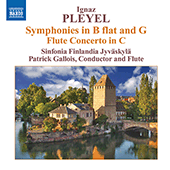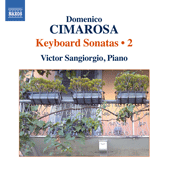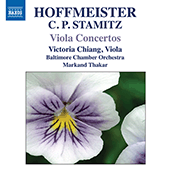Reviews of Recordings of Artaria Editions Works
 |
Ignaz Pleyel (1757-1831) Symphonies in B flat major and in G major/ Flute Concerto Symphony in B flat, Benton 125 (AE206) Sinfonia Finlandia Jyväskylä / Patrick Gallois Release date: 01/2012
For a brief period the music of Ignaz Pleyel enjoyed a popularity that exceeded his mentor, Joseph Haydn, though by his death it had almost become forgotten. Born in 1757, he had been fortunate enough to have the patronage of Count Erdody who funded his education, later appointing him as his kapellmeister and then provided the money for his years submerged in Italian music. He was to undergo a change of direction in his later years when his time was largely placed at the disposal of his flourishing music publishing business and piano manufacturing. We will never know if he would have developed his style, but when he died in 1831 it was already dated, and Beethoven had arrived. The two symphonies on this release come from the 1780's when he was in his most productive period, and were cast in the conventional four movements. Though others find influences of Italian music in his works, to my ears these scores come in straight lineage from Haydn, with some bold horn writing in outer movements. Maybe they needed more substantial Minuets, but the G major is certainly in the same league as early Haydn, both exhibiting a high degree of craftsmanship. It would appear the Flute Concerto dates from the late 1790's and is played in a recent edition by Jean-Pierre Rampal. It is in the style of orchestral passages followed by those for a virtuoso flute with a functional orchestral backdrop. ...it is always pleasing with a brilliant cadenza in the first movement...The performance from Patrick Gallois is excellent, while his direction of the Sinfonia Finlandia brings suitable incisive playing to outer movements.
|
|
David Denton |
|
 |
Keyboard Sonatas, Vol.2 Sonatas R.19-R.39 (AECS) Release date: 12/2011
Domenico Cimarosa's output of some sixty-five operas placed him among the most famous Italian composers in the second half of the 18th century. But did he really also compose music for the keyboard? Well there is not a shred of evidence they were from his hand, and were 'discovered' almost a hundred and twenty-five years after his death in an apparent copy. That no original has ever been found, and that such a famous composer should never have had them published establishes almost beyond reasonable doubt that they are not his works. Yet, as, the present editor of a new edition asks 'why deprive him of the credit of having composed these sparkling little sonatas', and as no one has wanted to claim them, we have no other name for them. They are all quite short, some only in one movement, the sonata in G major hardly lasting one minute. That in itself would point to someone unaccustomed to writing arias. Still they are mostly lively, lightweight and with charm, the decorations around the melody creating a nice web of filigree. You could also question why, on the evidence of this disc, a supposedly top Italian composer did not have the pungency of his predecessor, Domenico Scarlatti. That, to some measure, can be explained by the fact they are here played on a modern piano when the more percussive harpsichord of his time would have created a very different sound. In total there are 87 sonatas attributed to his name, of which this second volume includes seventeen. The Italian pianist, Victor Sangiorgio, plays with admirable clarity? Recorded in the UK to a very high quality. |
|
David Denton |
|
 |
Franz Anton Hoffmeister (1754-1812) Carl Stamitz (1754-1801) Viola Concertos Carl Stamitz Viola Concerto No.1 in D Victoria Chiang, viola / Baltimore Chamber Orchestra / Markand Thakar Naxos 8.572162
These are attractive, elegant works in a somewhat generic classical style, with singing opening allegros employing triadic themes, touching slow movements with some minor-key inflections, and perky rondo finales. The two works by Hoffmeister have a bit more harmonic interest and rhythmic tension than the more aristocratic Stamitz piece, but the differences aren’t huge. Victoria Chiang plays with a big tone and lots of enthusiasm, and since she’s rather closely recorded it’s a good thing that her intonation is so accurate, even in double-stops. The Baltimore Chamber Orchestra is a modern-instrument group, which certainly isn’t a disadvantage. The playing is polished and always falls gratefully on the ear. In the first movements, I could imagine perhaps a bit more energy, but this is a very minor issue. Aside from the forward balance of the soloist (understandable in any work for viola and orchestra), the engineering is warm and natural. A very pleasant release. |
|
David Hurwitz Franz Anton Hoffmeister was doing very nicely as a composer when he decided to enter the field of music publishing. That not only made him a wealthy man, but also gave him a channel to disseminate his own music internationally. The result was a composer who became prolific in his output, though why he composed the two viola concertos is unknown as such works would not enjoy a ready market at the time. Their date of composition is uncertain though the 1780’s seems likely and places them before the foundation of his publishing house. They are robust works employing the instrument to good effect, the frequent use of the lower register being a particularly pleasing aspect, while the lyric and flowing central movement of the D major is delightful. Outer movements offer an orchestral role of substance, with the Rondo finale to both concertos being bright and cheerful. Maybe the two works are too similar to be heard together–even the length of the movements are almost exactly the same–yet with Victoria Chiang’s dexterity, impeccable intonation and appealing tonal quality they do make for relaxing enjoyment. With Carl Stamitz the situation was very different, for as a performing musician highly regarded on both violin and viola, the dearth of concerto material available for the viola made his own scores very valuable to him. This first concerto was published in 1774, but it is likely he performed it the previous year. In every way it was comparable in style, content and quality with works composed by Mozart at that time, Chiang revelling in the moments of virtuosity. Stylish and well balanced support from the Baltimore players; exemplary programme notes from Allan Badley, and good sound engineering. Much recommended. |
|
|
David Denton |
|
|
|
Ries, Ferdinand (1784-1838) Piano Concertos Vol. 4 Piano Concerto Pastoral No. 5 in D, Op.120 (AE479) Christopher Hinterhuber, Piano / Bournemouth Symphony Orchestra / Uwe Grodd Naxos 8.572088 Championing Franz Anton Ries has become one of Naxos’s most deserving and successful ventures. As a favourite pupil of Beethoven his credentials were impressive, but it was his move to London in 1813 that was the defining moment in his life. Finding such a dearth of good quality musicians he was happy to be adopted and established as England’s finest pianist-composer of his time. Yet having built a financial fortune, he was to retire at the age of 40 and returned with his English wife to his native Rhineland. Among his formidable catalogue of composition are eight piano concertos that have been passed down and are part of this on-going series. The date of composition of the Concerto Pastoral is unclear, but it may just have predated his arrival in England. The surpriser comes in the similarity to Mendelssohn, though at this date he had yet to compose a note. It is a decorative work, the piano often just dancing around the orchestra, and there is sufficient weight to question the inclusion of ‘pastoral’ in the title. It shares with the even earlier Fourth Piano Concerto the conventional form of two fast movements surrounding a slow one, the sound of a hunting horn directly leading into the brilliant final allegro of the Concerto Pastoral. The fourth concerto starts where that work left off, the music bubbling with vitality, and has pre-echoes of Chopin yet to come. The central movement never finds a memorable theme, but is short, and gives way to a sparkling finale. The Introduction and Rondeau Brillant is a late work unpublished when he died. It makes a happy and lengthy ‘encore’ to the disc. The performances from Christopher Hinterhuber ooze with charm, conductor, Uwe Grood, and the Bournemouth orchestra keeping a pleasing backdrop. Very good sound quality. |
|
David Denton |
|
|
|
Ries, Ferdinand (1784-1838) Flute and Piano works Flute Sonata in E flat major, Op. 169, “Sonate sentimentale” (AE441) Uwe Grodd, Flute/ Matteo Napoli, Piano Naxos 8.572038 Born in Germany in 1784, Ferdinand Ries’s move to London in 1813 changed his life, the dearth of quality musicians that worked there placing him as England’s finest pianist-composer of his time. He was in such demand that he quickly built a personal fortune, and at the age of 40 he retired, returning to his native Rhineland together with his English wife. A highly commercial composer, he wrote a substantial output intended for sale as sheet music for the gifted amateur. The booklet with the disc is quite candid in saying ‘they may not represent the best of Ries’s works but they serve to illustrate the consummate professionalism he brought to everything he wrote’. They came from a period where elaborate decoration was in vogue, the Variations on a Portuguese Hymn—which turns out to be Adeste fideles (Oh come all ye faithful)—being a typical example. The Sonate sentimental and G major Sonata are more substantial in stature, with dramatic moments that seek to please. That he was a pianist is always evident, as the finest and most demanding writing is for the keyboard, and nowhere more so than in the Introduction and Polonaise. Uwe Grood, the New Zealand-based flautist, is in fine form, with his Italian partner, the much experienced Matteo Napoli, making light of the many demands. Much enjoyed as it drifted past me, the UK made recording is of very good quality. |
|
David Denton |
|




